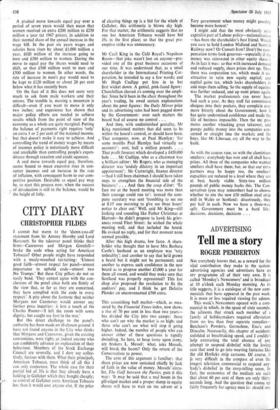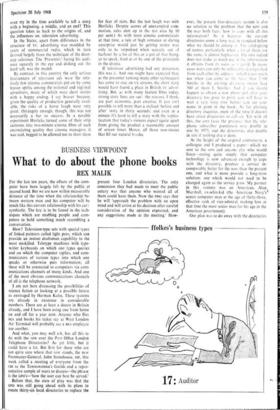Tell me a story
ADVERTISING ROGER PEMBERTON
Not everybody knows that, as a reward for the vital contribution they make to the system. advertising agencies and advertisers have an riv programme all of their very own. It is called 'Monday's Newcomers' and is broadcast at 10 o'clock each Monday morning. As its title suggests, it is a catalogue of the new com- mercials that have appeared in the past week. It is more or less required viewing for admen.
This week's Newcomers opened with a com- mercial in which, in the space of sixty seconds, the ailments that struck each member of a family of holidaymakers required alleviation from no less than four separate remedies- Beecham's Powders, Germolene, Eno's and Diocalm. Necessarily, this chapter of accidents unfolded at breathtaking speed, and I couldn't help contrasting the total absence of any attempt to suspend disbelief with the loving care that used to go into weaving fantasies like the old Horlicks strip cartoons. Of course, it is very difficult in the compass of even the longest television commercial to suspend any- body's disbelief in the story-telling sense, In fact, the economics of the medium are such that about 60 per cent of them are only thirty seconds long. And the question that comes up fairly frequently for agency men is: should one
even try in the time available to tell a story with a beginning, a middle, and an end? This question takes us back to the origins of, and the influences on, television advertising.
In the States, apart from differences in the structure of TV, advertising was moulded by years of commercial radio, which in turn derived largely from the technique of the door- step salesman. The 'Presenter,' facing his audi- ence squarely in the eye and dishing out the hard sell, was the model.
By contrast, in this country the only serious forerunners of television ads were the rela- tively few cinema commercials put on by some braver spirits among the national and regional advertisers, many of which were short stories with a happy ending. I say braver because, given the quality of production generally avail- able, the risks of a horse laugh were very great. (Strangely enough, though, this was not necessarily a bar to success. In a notable experiment Horlicks turned some of their strip cartoons into two-minute cinema films of such excruciating quality that cinema managers, it was said, begged to be allowed not to show them
for fear of riots. But the last laugh was with Horlicks Despite scenes of unexampled com- motion, sales shot up in the test area by 10 per cent.) As with most cinema commercials at that time, a tale of high romance or daring enterprise would just be getting under way only to be torpedoed when scarcely out of harbour by a tin of this or a pot of that being, so to speak, fired at or by one of the principals in the drama.
If television advertising had any precursor, this was it. And one might have expected that, as the presenter (among many other techniques) has come to stay on us screens, the short story would have found a place in British TV adver- tising. But, as with many feature films today, strong story lines are out : the reasons, I think, are part economic, part creative. It just isn't possible to tell more than a stylised 'before and after' story in thirty seconds; and even in a minute it's hard to tell a story with the sophis- tication that today's viewers expect (quite apart from giving the product a reasonable amount of screen time). Hence, all those non-stories that fill our natural breaks.







































 Previous page
Previous page